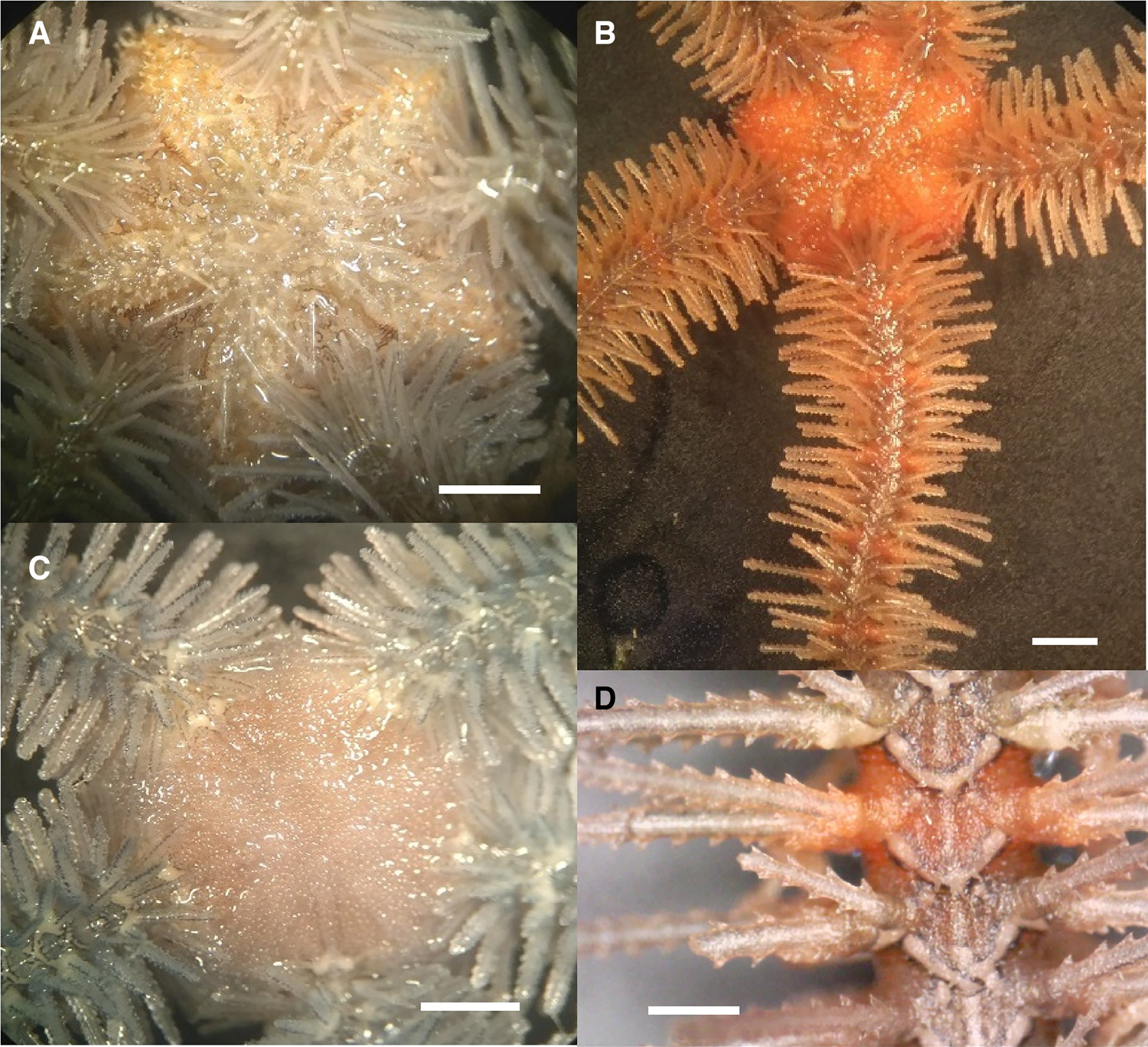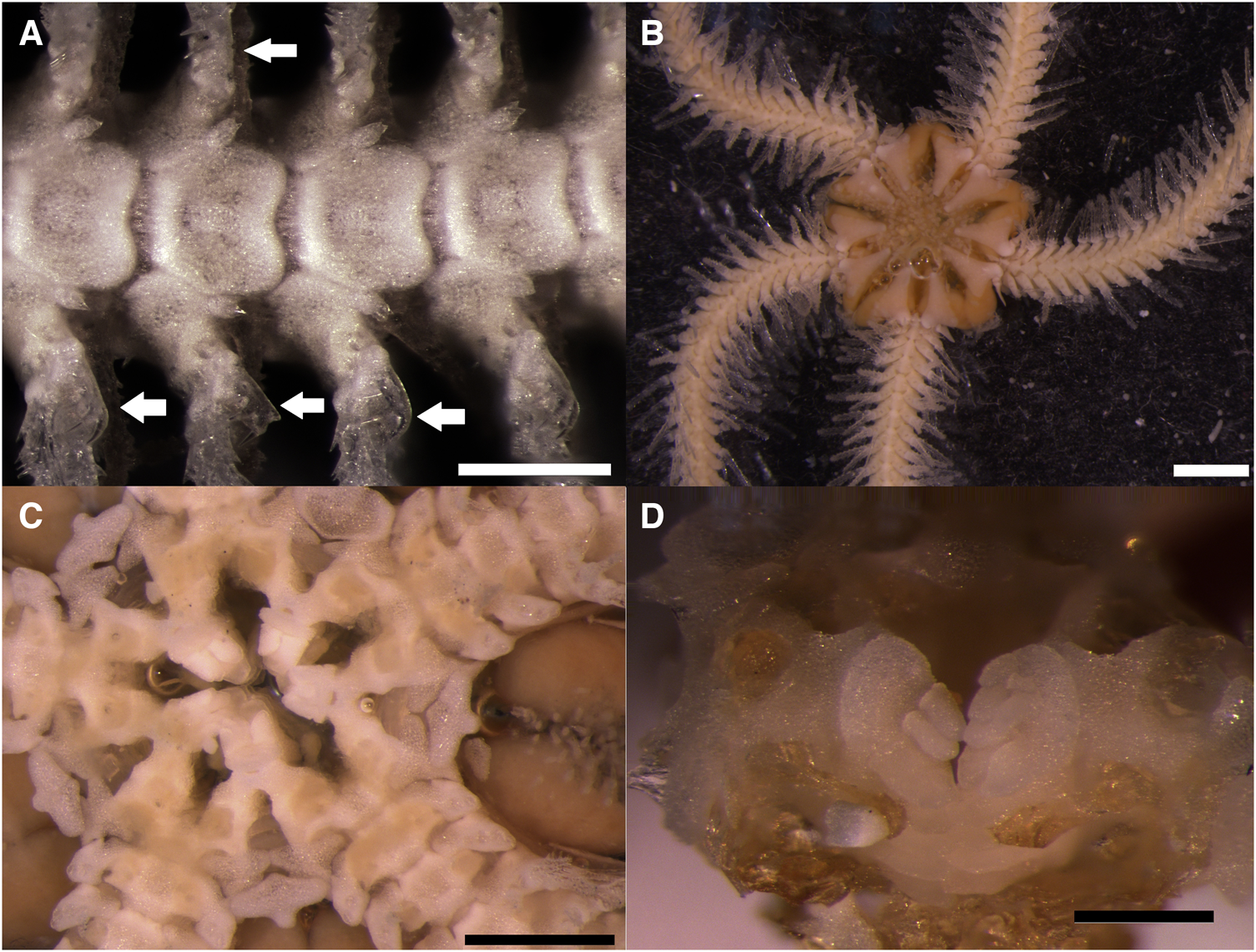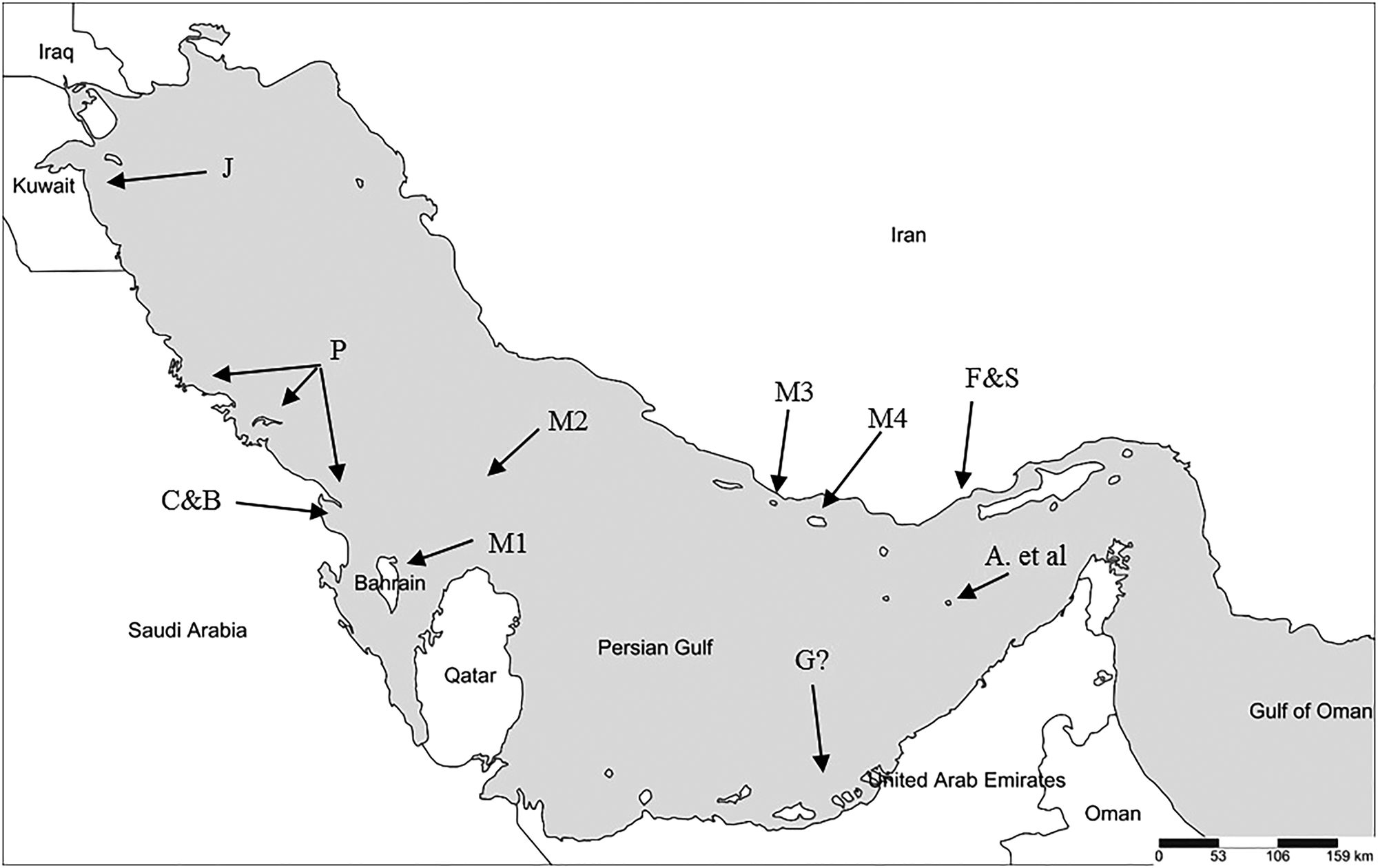Introduction
Despite the many reports available on the Echinodermata of the Persian Gulf, there is limited information on their presence and distribution. The only comprehensive studies that have been done on the distribution of echinoderms in the Persian Gulf are Mortensen in the north and Price from south of the Persian Gulf (Mortensen, Reference Mortensen1940; Price, Reference Price1981, Reference Price1983). Before Mortensen's studies, only ten echinoderms were reported from Persian Gulf (Mortensen, Reference Mortensen1940). Other studies conducted so far have generally been focused on a limited area of the Persian Gulf (Fatemi et al., Reference Fatemi, Jamili, Valinassab and Kuranlu2010; Pourvali, Reference Pourvali2015; Peyghan et al., Reference Peyghan, Doustshenas, Nabavi, Rounagh, Larki and StÖhr2018). Recently, new data on Ophiuroidea have been published for the Persian Gulf and Oman Sea which identify 38 species in the study area, but which does not provide data on the distribution of the specimens (Fatemi and Stöhr, Reference Fatemi and Stöhr2019). Ophiothrix savignyi is described in more detail because in some cases it has been misidentified.
Currently, more than 90 species of Ophiothrix are known worldwide (Alitto et al., Reference Alitto, Amaral, Oliveira, Serrano, Seger, Guilherme, Di Domenico, Christensen, Lourenço, Tavares and Borges2019; Santana et al., Reference Santana, Manso, Almeida and Alves2020). Only two species belonging to Ophiothrix, including O. savignyi and O. purpurea have been reported from the Persian Gulf (George, Reference George, Riegl and Purkis2012; Fatemi and Stöhr, Reference Fatemi and Stöhr2019).
The Iranian waters of the Persian Gulf include 990 kilometres of coastline and more than 40 islands (Yazdani and Yanzhe, Reference Yazdani and Yanzhe2022) and feature a variety of ecosystems; such as coral reef, mangrove, seagrass, sandy, muddy, and rocky substrates. Ophiuroidea are considered one of the main benthic groups with high abundance and diversity (Santana et al., Reference Santana, Manso, Almeida and Alves2020) and great ecological importance, especially in marine ecosystem and benthic food webs (Willey, Reference Willey1968; Barnes, Reference Barnes1982).
This study aimed to determine the distribution and morphological features of Ophiothrix savignyi (Ophiuroidea) in the northern and eastern Persian Gulf. Also O. savignyi could be found in different habitats were described.
Materials and methods
Data sampling
The present study was conducted from 2017 to 2022 in different areas in the Iranian waters of the Persian Gulf from tidal areas to a depth of 17 m. Figure 1 shows the places where Ophiothrix savignyi was observed in this study and also the previous reports have been illustrated as red marks in the northern and eastern Persian Gulf. Table 1 explains the number of stations which were surveyed in each location of sampling and the maximum depth of sampling (appendix 1 explains all site sampling which have been surveyed).

Figure 1. Sampling sites in Persian Gulf, 1. Qeshm Is. 2. Hormuz Is. 3. Larak Is. 4. Hengam Is. 5. Abu Moussa Is. 6. Farur Is. 7. Kish Is. 8. Lavan 9. Shidvar Is. 9. Khark & Kharku Is. 10. Bushehr 11. Dayyer Port 12. Kangan 13. Shirinoo 14. Nayband Bay 15. Parsian 16. Bostaneh & Bandar-e Lengeh.
Table 1. Depth and number of station sampling

The number of stations that were surveyed by diving in each location, including the number of specimens sampled. Number of each row is set with the exact station showed in Figure 1.
Data analyses
The collected samples were first immobilized in freshwater, then fixed in 70% ethanol. To identify the samples, the identification keys of Price (Reference Price1983) and Clark and Rowe (Reference Clark and Rowe1971) were used. The digital images were taken using a stereo-microscope equipped with a camera (LEICA DFC 450) and the images were prepared by the Helicon software (Helicon Focus 6.7.1).
Voucher specimens were registered in the collections of the Zoo Systematic Museum of Bahonar University, Kerman (ZSMBUK), Iran, and the registration number is given below.
Results
Systematic description
Order: Amphilepidida O'Hara, Hugall, Thuy, Stöhr & Martynov, 2017
Family: Ophiotrichidae Ljungman, 1867
Genus: Ophiothrix Müller & Troschel, 1840
Ophiothrix savignyi Müller & Troschel, 1842
Price, Reference Price1983, P. 65–67, Fig. 29; Clark and Rowe, Reference Clark and Rowe1971, P. 109, Fig. 22g, Pl.15 fig. 1; Fatemi and Stöhr, Reference Fatemi and Stöhr2019, Fig. 5; George, Reference George, Riegl and Purkis2012, Fig. 13.10 I;
Original name:
Ophionyx savignyi Müller & Troschel, 1842
Synonymised names:
Ophionyx savignyi Müller & Troschel, 1842 ⋅ unaccepted
Ophiothrix beata Koehler, 1907 ⋅ unaccepted (synonymized by Mortensen (1926))
Ophiothrix otiosa Koehler, 1898 ⋅ unaccepted
Ophiothrix savignyi (Müller & Troschel, 1842) ⋅ alternative representation
Material examined
In all, 73 specimens were collected from different regions in the northern and eastern Persian Gulf, at least one sample from each station (ZSMBUK, 1639/1–1639/72).
Description
A small brittle star with five arms which is commonly an epibiont on sponges and sometimes on other invertebrates like Echinoidea (Prionocidaris baculosa) and zoanthids, the diameter of its disc rarely exceeds 8 mm (all specimens measured between 2 and 8 mm).
A) Shape and colour: The live specimens mostly have stellar disc in shape, but some shows pentagonal to circular disc (Figure 2). The colour of live specimens is extremely variable, generally being patterned but some of the uniform colours (red, yellow and brown) have been recorded, sometimes there is a light line along the middle of dorsal arms banded with two thin dark lines (Figure 3G), which is not common among all specimens or if present, not necessary for the entire arm.
B) Dorsal disc: Dorsal disc is covered with numerous trifid stumps or with long and thin spines, also some specimens were observed with a mixture of stumps and spines (Figures 2A, 2C, 3C, 3F), extending V-shaped to the ventral interradii (Figure 3E). The triangular large radial shields are more than half of the radius disc in length (Figure 4F).
C) Ventral disc: Oral shield appear slightly wider than their length when viewed from above; adoral shield meeting proximally; sometimes, both oral and adoral shield are not clearly visible; the jaws are equipped with a cluster of apical tooth papillae, where the marginal tooth papillae are longer than the central ones (Figures 3E & 4C); a hole at the centre of the jaw, just proximal to the adoral shield and distal to the apical papillae.
D) Arms: Dorsal arm plates rhombic to fan shape with proximal straight and distal nearly convex in the end corner, appear slightly wider than their length and in some cases, bearing a fine longitudinal protrusion along the middle of the dorsal arms, sometimes having small thrones in distal end (Figure. 2D & 3G); ventral arm plates are square to cup-shaped, flat proximally and concave distally; plates are totally separated from each other (Figures 3H & 4A); up to eight glassy arm spines which are saw edged in the distal and the proximal side of the spine; the first two proximal arm segments have shorter spines compared to the rest of the arm, and by the third segment, the length of the lateral spines reaches up to 4 times the length of each segment; the lowest spines decrease in size and change shape, appearing to form hooks towards the disc (Figure 4A). Arm length reach 5–6 times the diameter disc.

Figure 2. (A) Dorsal disc complex of trifid stumps and spine (ZSMBUK 1639/65), (B) uniformity in color (ZSMBUK 1639/53), (C) dorsal disc covered just by trifid stumps (ZSMBUK 1639/39), (D) longitudinal protrusion in dorsal arm plates and distal throns (ZSMBUK 1639/53). (Scale bar, A. B. C. 1 mm, D. 500 μm).

Figure 3. Ophiothrix savignyi, (A) live specimens living on sponge, (B & C). Dorsal view, (D & E) ventral view (ZSMBUK 1639/18), (F) dorsal view of disc showing complex of trifid and spines (ZSMBUK 1639/21), (G) Dorsal arm plates with middle dorsal line and distal spine (ZSMBUK 1639/21), (H) ventral arm plates (ZSMBUK 1639/21). (Scale bar, B. C. D. 2 mm, E. H. 1 mm, G. 500μm, F. 200 μm).

Figure 4. (A) ventral arm plates and showing the lowest arm spine, (B & C) dorsal and ventral view of bleached specimen, (D) showing apical jaw with papillae (ZSMBUK 1639/22) (scale bar A, D. 500 μm, B 2 mm, C. 1 mm).
Distribution
Present study: Although O. savignyi is epibiont on sponges, they exist on all hard seabed on which sponges could be found from the intertidal area to the depth of 18 m, even on artificial substrates. O. savignyi was observed in the following locations: Bushehr, Owli-ye Jonubi (a small village next to Dayyer), Shirinoo, Kangan, Nayband Bay, Parsian, Bostaneh, Bandar-e Lengeh in the main land and also Qeshm, Hengam, Larak, Hormuz, Farur, Kish, Lavan, Shidvar, Abu Mousa, Khark, and Kharku Islands. It should be mentioned that the specimens were observed in tidal pool in Bustaneh, Bandar-e Lengeh, Bushehr, Owli-ye Jonubi, Qeshm, and Hormuz Islands. O. savignyi was epibiont on Prionocidaris baculosa (Echinoidea) at Hengam Island (~ 7 m) and Kish Island (~ 12 m). Moreover, it was found epibiont on zoanthid in the Qeshm Island. An exception was its occurrence as epifauna on marine cage culture nets between the north Kish Island and Aftab.
In some cases, O. savignyi have been observed in intertidal area with tidal pool (Table 1).
Previously reported for the Persian Gulf (Table 2; Figure 5).
Table 2. Previous report of O. savignyi. Substrate of observation with the number of collected specimen


Figure 5. Previously reported O. savignyi in the Persian Gulf. (A) Abu Mousa, Abdollahi et al.; C&B: Clark and Bowen, Tarut Bay; G?: George, (No exact location from United Arab Emirates); J: Jones, Kuwait sea shore; M 1–4: Mortensen (M1: Bahraih, M2: Stieff's Bank, M3: Chiru, M4: Kish Island); P: Price, Sea shore of Saudi Arabia.
Mortensen reported O. savignyi for the first time in the Kish Island, Stiffe's Bank, Chiru, and Bahrain from the Persian Gulf (Mortensen, Reference Mortensen1940). Clark and Bowen observed O. savignyi for the first time in the Tarut Bay and vicinity at the Arabian shore in the south of the Persian Gulf (Clark and Bowen, Reference Clark and Bowen1949). Price reported echinoderm species such as this species from Safaniya, Jana and Jurayd Islands, Berri platform J, Berri Well, Abu Ali, Jubail, Juahmah, Ras Tanura boat pier, Tarut Bay, and Dummam Channel in southern Persian Gulf (Price, Reference Price1981, Reference Price1983). Jones (Reference Jones1986) has reported O. savignyi from Kuwait shore. Recently, O. savignyi have been observed in United Arab Emirates in southern Persian Gulf (George, Reference George, Riegl and Purkis2012) and Bostaneh and Abu Moussa Island in northern Persian Gulf (Fatemi and Stöhr, Reference Fatemi and Stöhr2019; Abdollahi et al., Reference Abdollahi, Darzi, Rahimian and Naderloo2020). Figure 2 shows the distribution of previous reports for O. savignyi in the Persian Gulf.
Worldwide distribution (×Figure 6): Distributed in Indo-West Pacific area including: Mascarene Island, East Africa and Madagascar, Comoros, Red Sea, South East Arabia, Persian Gulf, West India and Pakistan, India, Ceylon Area, Philippines Island, South China Sea, Australia, Japan, Tanzania, Kenia, and New Caledonia (Clark and Rowe, Reference Clark and Rowe1971; Humphreys, Reference Humphreys1981; Price, Reference Price1983; Baroliya et al., Reference Baroliya, Solanki and Kundu2022).

Figure 6. Worldwide distribution of Ophiothrix savignyi.
Discussion
Several researchers have reported Ophiothrix savignyi in different regions of the Indo-West Pacific. These reports indicate the existence of some distinct morphotypes of this species. In the present study, the collected specimens were morphologically similar to the species collected by Price, Reference Price1983 from the southern Persian Gulf.
In the present study, O. savignyi is an epibiont on sponges in most areas of the Persian Gulf. Also, it was reported as a symbiont of O. savignyi with sponges in the Red Sea (James and Pearse, Reference James and Pearse1971). Previously, the presence of this species was recorded in the tidal pools under boulders in the southern Persian Gulf (Clark and Bowen, Reference Clark and Bowen1949).
Also, this species was found in a depth exceeding more than 5 m associated with soft corals in Nicobar Island in India (Sadhukhan et al., Reference Sadhukhan, Raghunathan and Venkataraman2012). George (Reference George, Riegl and Purkis2012) stated that O. savignyi is generally seen as a symbiont on sponges, both in cervices and on exterior surface, on subtidal hard bottom of 0–32 m depth and shows considerable colour pattern variation on its dorsal surface. On the other hand, this species have been recorded in sandy substrate areas. (Parameswaran and Saravavnane, Reference Parameswaran and Saravavnane2021). In general, Price (Reference Price1983) has identified various ecosystems as the habitat of this species, including: subtidal rock and sand, subtidal mud, coral reef, artificial structures and finally, sand and rock tidal flat from 0 to 32 m depth.
Although, in most of the currently studied areas, sponges were seen as symbiotic hosts for O. savignyi; other observed hosts for this species were sea urchin (Prionocidaris baculosa) in the Khark and Hengam Islands) and living on breeding cages in the sea.
Although Fatemi and Stöhr have reported O. savignyi as a symbiont of Subergorgia suberosa in the tidal pool area, the mentioned soft coral does not seem to exist in the tidal pool, it rather exists at more than 10 m in the Persian Gulf. Although, they emphasized the absence of thorns on the dorsal arm plates (Fatemi and Stöhr, Reference Fatemi and Stöhr2019), however; our samples show these thorns (Figures 2D & 3G) on the dorsal arm plates.
Koushik and coworkers explain that O. savignyi has naked ventral interradius (Koushik et al., Reference Koushik, Raghunathan, Venkataraman, Venkataraman, Sivaperuman and Raghunathan2013). But, on the taken photos in this study, ventral side of the disc is not clear. Dorsal arm plate is hexagonal, thin and flat in structure; arm spines and arm plates are very transparent. These characteristics did not match the description of the O. savignyi and probably the species examined by Koushik and coworkers may not be O. savignyi.
Some brittle star species such as Amphioplus echinulatus have only been reported once and some species introduced in the Persian Gulf such as Ophiocoma scolopendrina and Macrophiothrix hirsuta have a limited ecological niche and occurred in low distribution compared with O. savignyi. On the other hand, a variety of hosts for the O. savignyi makes it possible to see this species in various substrates and at different depths. Also, O. savignyi was introduced as a brittle star species with high abundance in Tarut Bay and its vicinity this is in agreement with the present study (Clark and Bowen, Reference Clark and Bowen1949).
Except Kish and Abu Mousa Islands and also Bostaneh Port which previously have been reported as a location for O. savignyi, 16 new locations are reported as the presence of O. savignyi. Based on the findings of the present study, O. savignyi generally inhabits hard substrate throughout the Persian Gulf.
Supplementary Material
The supplementary material for this article can be found at https://doi.org/10.1017/S0025315425000062.
Acknowledgements
The first author is grateful to Dr Ali Reza Rastgoo and Dr Amir Mozafar Hosseini for valuable support during some scuba diving and Dr Reza Naderloo for providing access to the digital camera at the University of Tehran.
Author Contributions
NP, MS, and NS conceived and designed research. NP, MA, and MSR had conducted field sampling. NP, MS, and MA had conducted laboratory analyses. NP took photos on field and the laboratory. NP wrote the manuscript. All authors read and approved the manuscript.
Financial Support
No financial support.
Conflict of Interest
The authors declare none.
Data Availability
Data will be available on request.










